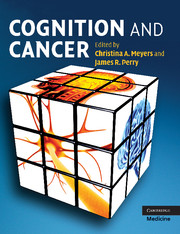Book contents
- Frontmatter
- Contents
- List of contributors
- Preface
- Section 1 Cognition and the brain: measurement, tools, and interpretation
- Section 2 Effects of cancer and cancer treatment on cognition
- Section 3 Interventions and implications for clinical trials
- 20 Behavioral strategies and rehabilitation
- 21 Support services
- 22 Pharmacological interventions for the treatment of radiation-induced brain injury
- 23 Neurocognitive testing in clinical trials
- Index
- Plate section
- References
20 - Behavioral strategies and rehabilitation
Published online by Cambridge University Press: 13 August 2009
- Frontmatter
- Contents
- List of contributors
- Preface
- Section 1 Cognition and the brain: measurement, tools, and interpretation
- Section 2 Effects of cancer and cancer treatment on cognition
- Section 3 Interventions and implications for clinical trials
- 20 Behavioral strategies and rehabilitation
- 21 Support services
- 22 Pharmacological interventions for the treatment of radiation-induced brain injury
- 23 Neurocognitive testing in clinical trials
- Index
- Plate section
- References
Summary
Significant cognitive impairment frequently accompanies cancer and cancer treatment for both adult and pediatric patients. As detailed in previous chapters, common cognitive complaints include cognitive slowing, deficits in attention, and memory inefficiencies. In people with brain tumors, cognitive impairments cause difficulty returning to work or school more often than physical impairments, and caregivers cite cognitive problems as the most difficult problems to manage (Meyers & Boake, 1993). For these reasons, evidence-based cognitive rehabilitation has the potential to meet prevalent needs for improving functional abilities in patients with cancer.
There is considerable focus in the literature on the general concept of quality of life in patients with many different kinds of cancer. Interventions to improve quality of life are often focused on symptoms of the cancer (e.g., physical limitations, decreased activity), physical symptoms related to treatment (e.g., fatigue, nausea, pain), health behavior change, or distress related to the diagnosis of cancer (e.g., Clark et al., 2003; Kuhn et al., 2005; Ronson & Body, 2002). However, very few studies specifically target cognitive symptoms in cancer patients and in fact, many studies exclude patients with cognitive impairment. Thus, the empirical literature on behavioral interventions for cognitive impairments in cancer patients is very limited.
In contrast, there is a long tradition of applying cognitive rehabilitation interventions in cases of acquired brain injury, specifically traumatic brain injury (TBI) and cerebral vascular accident (CVA).
- Type
- Chapter
- Information
- Cognition and Cancer , pp. 281 - 294Publisher: Cambridge University PressPrint publication year: 2008



